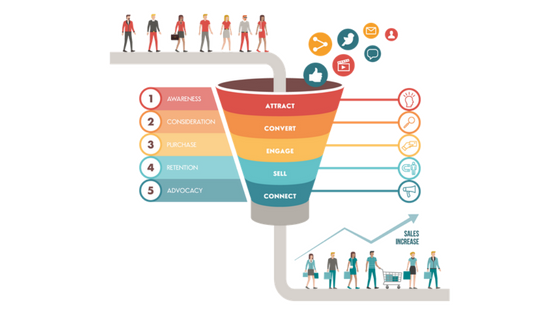When it comes to Marketing & Sales from a B2B perspective, there's no exact science on getting it right, however a clear understanding on how the both go hand in hand can go a long way in aligning your overall marketing objectives with a strong ROI.
What is the Marketing & Sales funnel?
To put it simply, the marketing and sales funnel is a visual representation of how to turn leads into customers from a Marketing & Sales standpoint.
What makes up the Marketing & Sales funnel?
The funnel is made up of stages in the consumer purchase cycle which takes them through a process to buying a product or service - this same logic also applies to B2B businesses, albeit with small tweaks throughout.

Awareness - The initial stage in the Marketing & Sales funnel, here the consumer/business is made aware of products or information through advertising campaigns, blog posts etc.
Interest - After first engagement (lead generation) the potential customer learns more of the offering through email, targeted content and newsletters for example.
Consideration - Now seen as prospective customers, through this stage marketers can continue to nurture leads through more targeted content, free trials and similar offerings.
Intent/Evaluation - This may differ from B2B and B2C as a product demo (B2B) or a product in a shopping cart (B2C) can help marketing teams develop an idea of truly interested customers. In the evaluation stage we normally see Marketing & Sales working together to convince a potential buyer.
Purchase - The final stage where Sales will take control of a purchase transaction, however it is important to know that this shouldn't end here totally, as both the Marketing & Sales team can use lead referrals to start the process again at the top of the funnel.
With a Fintech SEO agency you can do so much more for your ranking. Find out more here.
So what's the alternative?
As mentioned above, there's a presumption that the cycle simply ends once a purchase is made however this is not the case.
Hubspot call it the Flywheel. Where the customer is constantly central and service, marketing and sales revolves around this, instead of a top to bottom process which applies to both B2B and B2C.

For B2B businesses the above flywheel would put the business at the core of the attention on a more constant basis, which not only encourages sales, but promotes retention, further lead gen and positive reputation for a business.
How does B2B fit in to the Marketing & Sales funnel?
The Marketing & Sales funnel and subsequently the Flywheel are loosely fitted to accommodate both B2B and B2C strategies, however there are subtle differences along the way.
Top of funnel metrics like Awareness and Interest should remain relatively consistent across both, however when a B2B funnel differs is around the Consideration stage.
When it comes to nurturing your leads, it's important to know that communication between B2B is fit for purpose - ie. you're providing enough research, demonstrations , service info about your product or service.
Should B2B companies trust the Marketing & Sales funnel or the Flywheel?
It's important to understand that there's no clear winner between the two, as a combination of using both the Marketing & Sales funnel in conjunction with Hubspot's Flywheel means that business and customers are going through the process to purchase but instead of 'funnelling' out at the end, we see these return to repeat the process again and again.
